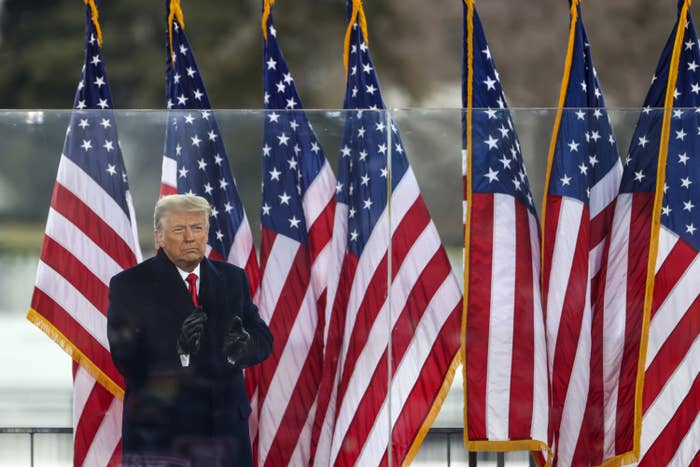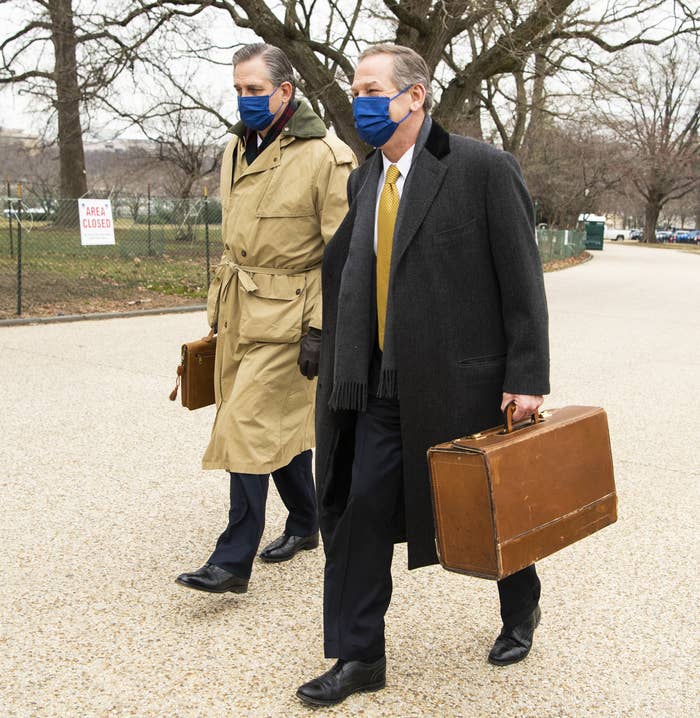
WASHINGTON — During a three-hour presentation on Friday afternoon, former president Donald Trump’s lawyers downplayed the scope of the violent insurrection at the US Capitol on Jan. 6 and presented false and misleading information about the riots.
Trump’s impeachment defense on Friday essentially boiled down to accusing Democrats of infringing on the former president's free speech rights under the First Amendment and taking his words out of context, denying that he meant it literally when he told his supporters on Jan. 6 to “fight like hell” shortly before the mob descended on the Capitol, and insisting that Democrats were hypocrites because they, too, had used the word “fight” in the past.
Trump’s lawyers tried to shift the focus away from the hours of video footage and timeline reconstructions that House impeachment managers had presented over the previous two days. They referenced a “small group” that “hijacked” the demonstrations on Jan. 6 — more than 200 people have been charged, and law enforcement officials have said there are hundreds more open investigations — and falsely suggested the mob was politically diverse. (The evidence has overwhelmingly identified participants as Trump supporters.) They downplayed evidence that prosecutors and defense lawyers have put forward directly linking the insurrection to Trump’s postelection conduct and his Jan. 6 speech.
“The reality is, Mr. Trump was not in any way, shape, or form instructing these people to fight or to use physical violence,” attorney Michael van der Veen argued, noting that the former president had also told his supporters that day to go to the Capitol and “peacefully and patriotically make your voices heard.”
The journalists at BuzzFeed News are proud to bring you trustworthy and relevant reporting. To help keep this news free, become a member.
In charging papers, prosecutors have laid out a pattern of Trump supporters explaining in their own words — via social media posts and videos, interviews with reporters, and, in a few cases, directly to the FBI — that they had come to Washington, DC, at the former president's urging, prepared for a violent confrontation or were spoiled for a fight, and understood they were following his direction and had his approval when they descended on the Capitol.
On Thursday, prosecutors described how Jessica Watkins, a member of the Oath Keepers militant group charged with conspiracy and other crimes in connection with the insurrection, was “awaiting direction” from Trump after the election.
Van der Veen instead accused the House impeachment managers of trying to pin blame on Trump “based on double hearsay statements of fringe right-wing groups based on no real evidence other than rank speculation.” He also falsely claimed that “the leader of antifa” was one of the first people arrested at the Capitol. No one charged to date has been described by the government as a member of antifa, let alone a leader.
The attorney didn’t specify whom he was referring to — but shortly after the riot, images of John Earle Sullivan began circulating in right-wing corners of the internet. Sullivan, a Utah man who had been arrested and charged with illegally going into the Capitol, had been involved in organizing racial justice demonstrations in Salt Lake City but has said he’s not affiliated with antifa or Black Lives Matter. The Washington Post reported that activists in Utah were suspicious of him and his motives. He’s also claimed that he’s not politically affiliated and that he was at the Capitol filming the events as a journalist. The government has disagreed with that last argument and presented quotes from videos where Sullivan can allegedly be heard urging on rioters.
Van der Veen argued that it was “apparent that extremists of various different stripes and political persuasions preplanned and premeditated” the attack. Prosecutors have presented evidence that small clusters of defendants planned for violence that day — but to date those defendants have been identified as Trump supporters, largely based on their public social media posts.

Trump’s lawyers devoted much of their presentation to arguments that the charges against the former president and the impeachment trial itself are unconstitutional. Van der Veen argued that the First Amendment’s free speech protections should shield Trump. He angrily decried a group of more than 100 constitutional scholars and lawyers who signed a letter before the trial calling the First Amendment argument “legally frivolous,” calling it an “outrageous attempt to intimidate” Trump’s legal team.
The overarching legal precedent cited by both Trump’s lawyers and House impeachment managers is Brandenburg v. Ohio, a 1969 decision from the US Supreme Court. The justices at the time drew a line between advocacy protected by the First Amendment — including hate speech and promoting violence — and speech “directed to inciting or producing imminent lawless action and is likely to incite or produce such action.”
To bolster their argument that Trump’s speech on Jan. 6 didn’t meet the legal standard for inciting “imminent” violence and that the trial would set a dangerous precedent for weaponizing impeachment against other elected officials in the future, the former president's lawyers devoted a significant amount of time to replaying video montages of Democrats using the word “fight.” The video, shown twice by Trump’s team, lasted nearly 10 minutes and featured clips of Democratic senators watching the trial; it included nearly two minutes of Sen. Elizabeth Warren saying the word "fight" during her presidential campaign.
His lawyers also tried to contrast the Jan. 6 violence and the widespread Black Lives Matter protests during summer 2020. “Many Democrat politicians endorsed and encouraged the riots that destroyed vast swaths of American cities last summer,” van der Veen said before showing footage of Democratic politicians speaking about protests.
Bruce Castor, another member of Trump’s legal team, repeated a statement he’d made earlier in the week that the former president and attorneys had denounced the violence of Jan. 6. He concluded the presentation by arguing that the trial was an example of “constitutional cancel culture” and accusing Democrats of trying to simply silence protected speech that they didn’t agree with. He also explained that they had decided not to use most of the 16 hours they’d been given to argue so that the Senate could “take back these hours and use them to get delivery of COVID relief to the American people.”
If you have a news tip, we’d like to hear from you. Reach out to us via one of our tip line channels.
Trump’s situation is unique in US history: He’s one of three presidents to be impeached and the first to be impeached twice; those previous Senate trials each took place while the president was still in office. But legal scholars and the Democratic impeachment managers have argued there is historical precedent for trying an executive branch official after they’ve left government. In 1876, then–secretary of war William Belknap resigned shortly before he was impeached by the House for “criminally disregarding his duty as Secretary of War and basely prostituting his high office to his lust for private gain.” He was tried, and ultimately acquitted, in the Senate.
The Constitution doesn’t directly address the question of whether a president can be impeached while in office and then tried in the Senate after leaving office. Legal scholars aren’t united in how to answer this question — Trump has had some prominent backers when it comes to his argument that the trial is unconstitutional — but the Congressional Research Service noted in a report on the subject last month that Democrats appear to be on stronger footing, at least academically.
One legal scholar cited by Trump’s lawyers in their brief has even said that they incorrectly cited him as concluding that the former president couldn’t be impeached. Brian Kalt, a professor at Michigan State University College of Law, wrote a law review article in 2001 about late-term impeachments and cited evidence on both sides. However, he made clear in a Twitter thread on Feb. 8 and in a Slate op-ed the next day that the article “favored late impeachability.”
Trump's brief cites my 2001 article on late impeachment a lot: https://t.co/ozArTm1aVe The article favored late impeachability, but it set out all the evidence I found on both sides--lots for them to use. But in several places, they misrepresent what I wrote quite badly. 1/4
Democrats managed to convince a majority of the Senate, including a handful of Republicans, to reject Republican Sen. Rand Paul’s effort to stop the trial from taking place on constitutional grounds. But the vote also showed Trump’s substantial support among the GOP and the steep odds Democrats face in getting the two-thirds majority needed to secure a conviction.
Article I of the Constitution gives the House of Representatives the power to impeach and the Senate the power to decide whether to convict. It also spells out the two possible consequences of a conviction: removal from office and disqualification from holding office in the future. Article II, meanwhile, which addresses the powers and functions of the executive branch, states that the president and other public officials “shall be removed from Office” if they’re impeached and then convicted of “Treason, Bribery, or other High Crimes and Misdemeanors.”
Trump’s lawyers have argued that Article II’s reference to removal as a consequence of impeachment makes the trial unconstitutional: Because Trump is no longer in office, he can’t be removed.
But Democrats and constitutional scholars have rejected this, saying that Article I has no language that restricts the Senate to only trying sitting presidents, as opposed to former ones. Article II makes clear what the baseline punishment is for conviction, these scholars say, not that the Senate can’t hold a trial at all if removal is no longer an option.

